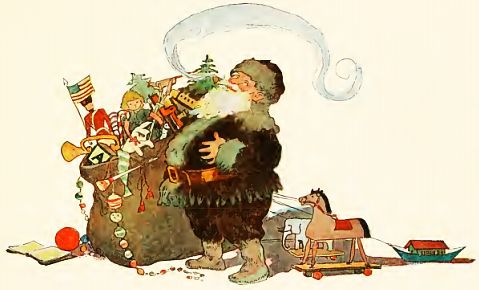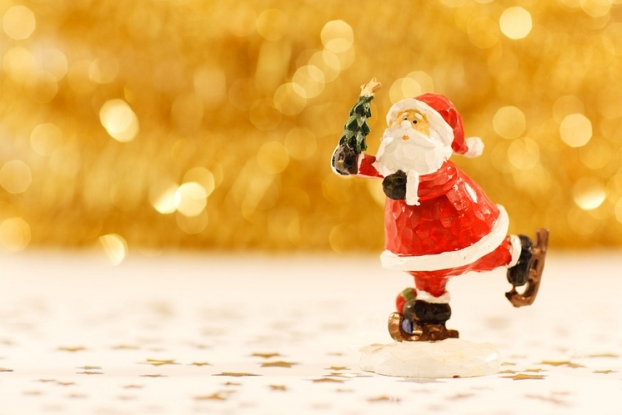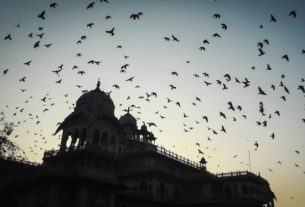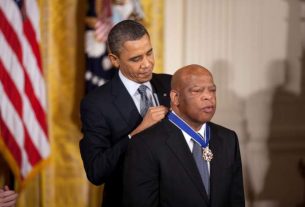The poem was originally published in December 23, 1823…

‘Twas the night before Christmas, when all thro’ the house
Not a creature was stirring, not even a mouse;
The stockings were hung by the chimney with care,
In hopes that St. Nicholas soon would be there;
The children were nestled all snug in their beds,
While visions of sugar plums danc’d in their heads,
– The opening lines of ‘Twas the Night Before Christmas.
‘Twas the Night Before Christmas or A Visit from St. Nicholas, by Clement Clarke Moore is arguably one of the most popular Christmastide themed poems ever written. The poem was originally published anonymously in Sentinel on December 23, 1823 and portrayed St. Nicholas, in an air-borne sleigh pulled by eight reindeer visiting houses and distributing toys for children on the Christmas Eve told through the eyes of a father. The poetry is short and simple and is pleasant to read and it follows a metrical form, which is almost similar to a limerick.
From the introduction of the edition from 1912 we can perceive Moore’s motivation behind writing the poem.
Clement C. Moore, who wrote the poem, never expected that he would be remembered by it. If he expected to be famous at all as a writer, he thought it would be because of the Hebrew Dictionary that he wrote. He was born in a house near Chelsea Square, New York City, in 1781; and he lived there all his life. It was a great big house, with fireplaces in it; — just the house to be living in on Christmas Eve.
Dr. Moore had children. He liked writing poetry for them even more than he liked writing a Hebrew Dictionary. He wrote a whole book of poems for them. One year he wrote this poem, which we usually call “‘T was the Night before Christmas,” to give to his children for a Christmas present. They read it just after they had hung up their stockings before one of the big fireplaces in their house. Afterward, they learned it, and sometimes recited it, just as other children learn it and recite it now.
This piece of poem that Moore wrote for his children Margaret, Charity and Mary influenced the physical appearance and the jolly bright personality of St. Nicholas in American popular culture pretty soon.
Lines like:
His eyes how they twinkled! his dimples how merry!,
And the beard of his chin was as white as the snow; ,
He had a broad face and a little round belly, That shook when he laughed, like a bowlful of jelly.,
and
he was chubby and plump, a right jolly old elf,
closely resemble the modern day popular depiction of Santa Claus.
Moore’s template for the Santa that he drew through his poetry soon replaced the centuries old characteristic depictions of St. Nicholas of Europe. The poem also influenced the ideas of Christmas Eve gifting and is believed to have popularized the concept of Santa visiting homes on Christmas Eve bearing gifts in America.

The poetry was soon reprinted in many newspapers and magazines and was also adapted for many musical renderings.
The edition, which I had with me, was published by Hougton Mifflin Company in 1912 and the poem was accompanied by cute and rich illustrations done by Jessie Willcox Smith, one of the most famous female illustrators in the US during the late 19th and early 20th centuries; a time period which is often regarded as the Golden Age of American Illustration. Born in 1863 in Philadelphia, Jessie Willcox Smith was a prolific contributor to a range of well known magazines and periodicals of the time like Good Housekeeping, Scribner’s and Collier’s . She also did illustrations for literary works like An Old-Fashioned Girl (Louisa May Alcott), A Child’s Garden of Verses (Robert Louis Stevenson), The Bed-Time Book (Helen Hay Whitney), Dicken’s Children (Charles Dickens) and Heidi (Johanna Spyri).
Jessie Willcox Smith was definitely influenced by French impressionist painters in her choice of colors and was equally proficient in working with a whole range of media like oil, watercolor, charcoal and pastels. A large percentage of her works reflects motherly love with children being portrayed as the main subjects. She passed away in 1935.
He sprang to his sleigh, to his team gave a whistle,
And away they all flew like the down of a thistle.
But I heard him exclaim, ere he drove out of sight,
“Happy Christmas to all, and to all a good-night. ”

The illustrations in this edition reflect the spirit and joy of Christmas and they portray the wonder, the cheer and the anticipation, in children on the night of Christmas Eve.






1 thought on “‘Twas the Night Before Christmas – and the modern day portrayal of Santa Claus”